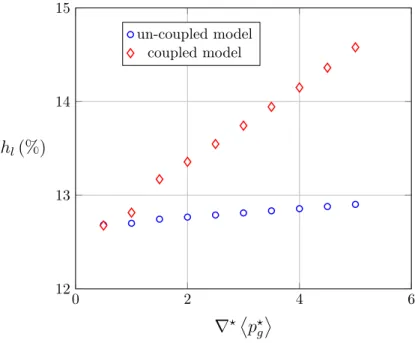HAL Id: hal-01394479
https://hal.archives-ouvertes.fr/hal-01394479
Submitted on 9 Nov 2016
HAL is a multi-disciplinary open access
archive for the deposit and dissemination of
sci-entific research documents, whether they are
pub-lished or not. The documents may come from
teaching and research institutions in France or
abroad, or from public or private research centers.
L’archive ouverte pluridisciplinaire HAL, est
destinée au dépôt et à la diffusion de documents
scientifiques de niveau recherche, publiés ou non,
émanant des établissements d’enseignement et de
recherche français ou étrangers, des laboratoires
publics ou privés.
Modeling of gas-liquid flow within structured packings
Sylvain Pasquier, Yohan Davit, Michel Quintard
To cite this version:
Sylvain Pasquier, Yohan Davit, Michel Quintard. Modeling of gas-liquid flow within structured
pack-ings. 13èmes Journéess d’études des Milieux Poreux 2016, Oct 2016, Anglet, France. �hal-01394479�
Modeling of gas-liquid flow within structured packings
S. Pasquiera, Y. Davita, M. Quintarda
aInstitut de M´ecanique des Fluides de Toulouse (IMFT) - Universit´e de Toulouse, CNRS-INPT-UPS, Toulouse
FRANCE
Keywords: two-phase modeling, porous media, separation processes
1. Introduction
Columns equipped with structured packings are commonly used in a variety of chemical engineering applications, such as distillation or absorption processes. However, modeling transport phenomena in such systems, including two-phase flow, remains a modern challenge. Here, we study the gas-liquid counter-current flow inside structured packings made of corrugated sheets oriented at two different an-gles. Momentum transport is often modeled using variants of Darcy’s law [3, 4], or one-dimensional Eulerian two-fluid models [1], where the effective parameters are determined via empirical or numerical analysis. However, the complexity of the physics at the pore-scale makes the up-scaling analysis a par-ticularly difficult problem. For instance, the dual structure at the pore-scale generates two preferential directions along the corrugated sheets, with an exchange of mass and momentum at contact points and strong liquid-gas interactions. In order to model the radial spreading due to the two preferential flow di-rections, multiple approaches have been suggested, including one-dimensional models that involve source terms capturing the radial spreading of the liquid phase [1]. Another proposition uses a decomposition of the fluid into two fictive phases, each one flowing along the adjacent sheets [2, 5]. This model includes additional terms to further capture mass exchange between the two films at contact points, reflecting the effects of the local geometry and capillary forces.
There are, however, still fundamental issues with these approaches. In particular, the exact amount of liquid that is exchanged at the contact points is unknown, making it difficult to develop constitutive laws. Soulaine et al. [5] introduced regional capillary pressures for the two pseudo-phases and assumed that the mass exchange rate is a function of the difference of the averaged pressure fields. In this study, we use a similar approach to that taken in Soulaine et al. and show that depending on the constitutive law that is chosen for the dependence of the saturation on the capillary pressures, a variety of flow regimes, ranging from liquid branching to almost 1D homogeneous flows, can be obtained. We also show that these singular regimes lead to different liquid dispersion and have a strong impact on the global retention in the column.
Another fundamental issue is the modelling of the gas-liquid coupling resulting from the interface shear stress. This interaction notably contributes to the liquid retention in the column, as well as to a higher gas pressure drop [6]. A few models [1, 2] account for these coupling effects using empirical closures for the shear-stress. In this work, we consider the form of the macro-scale laws emerging from an up-scaling analysis of a two-phase flow in porous media. Those models consist in Darcy-generalised equations with additional coupling terms reflecting the viscous interaction [7]. We then consider a system composed of three macro-scale momentum equations, that involve interaction terms to account for the liquid-gas coupling. The system of equations is solved at the macro-scale using the IMPES algorithm, which consists in a sequential resolution of the pressure and saturation equations. The effective parameters – namely, the intrinsic and coupling permeabilities – are estimated by calculating
analytically the velocity fields of a liquid film sheared by a gas phase in a circular channel. We show that the system of coupled laws provides a more accurate representation of the process than a system composed of classical Darcy’s laws. In particular, the increase of liquid retention prior flooding, is properly captured by the model (see Fig 1).
0 2 4 6 12 13 14 15
∇
?p
? gh
l(%)
un-coupled model coupled modelFigure 1: Liquid retention in the column as a function of the counter-current gas pressure drop - the coupled model permits to capture the increase of liquid retention in the column due to gas shear-stress
References
[1] I. Iliuta and C.F. Petre and F. Larachi, Hydrodynamic continuum model for two-phase flow structured-packing-containing columns, Chemical Engineering Science, 59, 879-888 (2004).
[2] B. Mahr and D. Mewes, Modelling and Calculation of Dynamic Two-Phase Flow in Columns Equipped with Structured Packing, Chemical Engineering Research and Design, 85, 1112 - 1122 (2007).
[3] W. Said, M. Nemer and D. Clodic, Modeling of dry pressure drop for fully developed gas flow in structured packing using CFD simulations, Chemical Engineering Science, 66, 2107 - 2117 (2011).
[4] C. Soulaine and M. Quintard, On the use of a Darcy-Forchheimer like model for a macro-scale description of turbulence in porous media and its application to structured packings, International Journal of Heat and Mass Transfer, 74, 88 - 100 (2014).
[5] C. Soulaine, P. Horgue, J. Franc and M. Quintard, Gas-liquid flow modeling in columns equipped with structured packing, AIChE Journal, (2014).
[6] R. E. Tsai, Mass Transfer Area of Structured Packing, University of Texas, Austin, (2010).
[7] S. Whitaker, Flow in porous media II: The governing equations for immiscible, two-phase flow, Transport in Porous Media, (1986).
